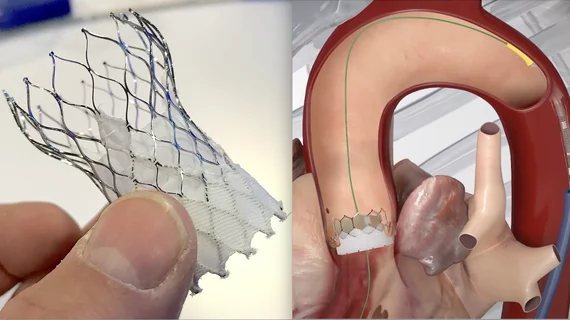VIDEO: The importance of assessing TAVR valve durability
Brian Lindman, MD, medical director of the Structural Heart and Valve Center and an associate professor of medicine at Vanderbilt University Medical Center, spoke with Cardiovascular Business about the tracking of transcatheter aortic valve replacement (TAVR) devices for signs of deterioration and how to assess long-term durability. The video interview was recorded at the American Heart Association (AHA) 2022 meeting.
With the TAVR trials over the past decade came systematic, apples-to-apples, annual follow-ups with echo to assess the valves, both surgical and TAVR.
"Out to five years, the newest generation valves are performing every bit as well as surgery, and in some cases are indicating a lower risk of structural valve degeneration," Lindman explained.
As TAVR now makes up more than 80% aortic valve replacement procedural volume, questions remain on the long-term durability of TAVR valves. Durability of TAVR valves has been assumed to be less than the average of a decade or two for surgical valves because of the need to be crimped and expanded into the valve position. However, durability out to five years has been shown to be very good so far.
Durability is important because younger patients are asking for TAVR. This raises the question if these patients are better candidates for surgical valves while they are younger and healthier, or if TAVR should be reserved as a second less invasive procedure later in life when a patient is more frail.
"As the TAVR trials have evolved and moved from prohibitive surgical risk, to high risk to intermediate risk and low risk, TAVR was shown to be non-inferior to surgery, and in some cases superior to surgery," Lindman said. "When you have that kind of outcome, combined with the fact that the recovery is a whole lot easier and simpler, it's understandable that many patients are going to want that less invasive approach."
He said there is a lot of interest in valve durability now because of an overall increase in patients coming forward to discuss valve replacements with cardiologists because of TAVR. Previously, many patients did not want open heart surgery or their referring cardiologist did not think they would survive the procedure, so were not even seen by a surgeon. Despite the rise in interest, the question about the durability remains. Lindman noted the data for surgical valves may not be as accurate as some physicians believe.
"I think a lot of the historic data on surgical valve degeneration is based on somewhat flawed studies in terms of looking at surgical re-intervention as the end point and not taking into account the fact that patients may have died, or developed severe structural heart degeneration and had gotten so sick that no one would treat them with re-do surgery," Lindman explained.
He pointed to the current long-term followup studies of TAVR vs. surgical aortic valve replacement (SAVR), which show they are about equal so far.
Some TAVR experts say the results are very promising, but data is needed for about a decade out from implants to have a better picture of how the two valve types really compare.
At AHA 2022, Lindman also spoke at a press briefing on the association launching a new effort to actively find more aortic stenosis patients. Because of TAVR, a much larger population of patients that perviously believe existed came forward seeking consultations. AHA now believes the aortic stenosis population is much larger and the under-treated than previously believed a decade ago.
Watch or read more on this in VIDEO: AHA says aortic stenosis is undertreated and underdiagnosed.

